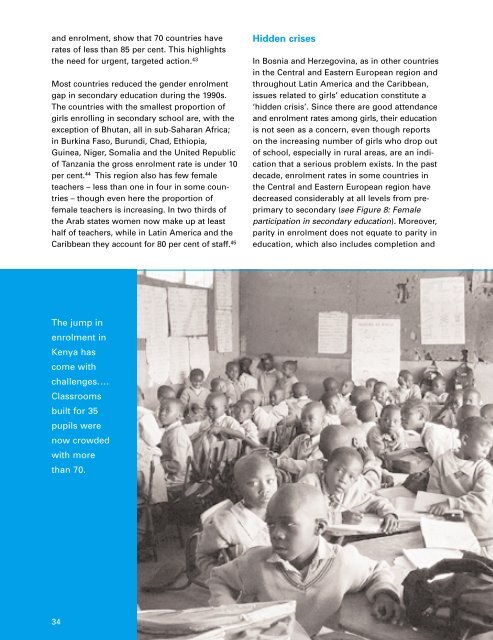THE STATE OF THE WORLD'S CHILDREN 2004 - Unicef
THE STATE OF THE WORLD'S CHILDREN 2004 - Unicef
THE STATE OF THE WORLD'S CHILDREN 2004 - Unicef
You also want an ePaper? Increase the reach of your titles
YUMPU automatically turns print PDFs into web optimized ePapers that Google loves.
and enrolment, show that 70 countries have<br />
rates of less than 85 per cent. This highlights<br />
the need for urgent, targeted action. 43<br />
Most countries reduced the gender enrolment<br />
gap in secondary education during the 1990s.<br />
The countries with the smallest proportion of<br />
girls enrolling in secondary school are, with the<br />
exception of Bhutan, all in sub-Saharan Africa;<br />
in Burkina Faso, Burundi, Chad, Ethiopia,<br />
Guinea, Niger, Somalia and the United Republic<br />
of Tanzania the gross enrolment rate is under 10<br />
per cent. 44 This region also has few female<br />
teachers – less than one in four in some countries<br />
– though even here the proportion of<br />
female teachers is increasing. In two thirds of<br />
the Arab states women now make up at least<br />
half of teachers, while in Latin America and the<br />
Caribbean they account for 80 per cent of staff. 45<br />
Hidden crises<br />
In Bosnia and Herzegovina, as in other countries<br />
in the Central and Eastern European region and<br />
throughout Latin America and the Caribbean,<br />
issues related to girls’ education constitute a<br />
‘hidden crisis’. Since there are good attendance<br />
and enrolment rates among girls, their education<br />
is not seen as a concern, even though reports<br />
on the increasing number of girls who drop out<br />
of school, especially in rural areas, are an indication<br />
that a serious problem exists. In the past<br />
decade, enrolment rates in some countries in<br />
the Central and Eastern European region have<br />
decreased considerably at all levels from preprimary<br />
to secondary (see Figure 8: Female<br />
participation in secondary education). Moreover,<br />
parity in enrolment does not equate to parity in<br />
education, which also includes completion and<br />
The jump in<br />
enrolment in<br />
Kenya has<br />
come with<br />
challenges.…<br />
Classrooms<br />
built for 35<br />
pupils were<br />
now crowded<br />
with more<br />
than 70.<br />
34
















